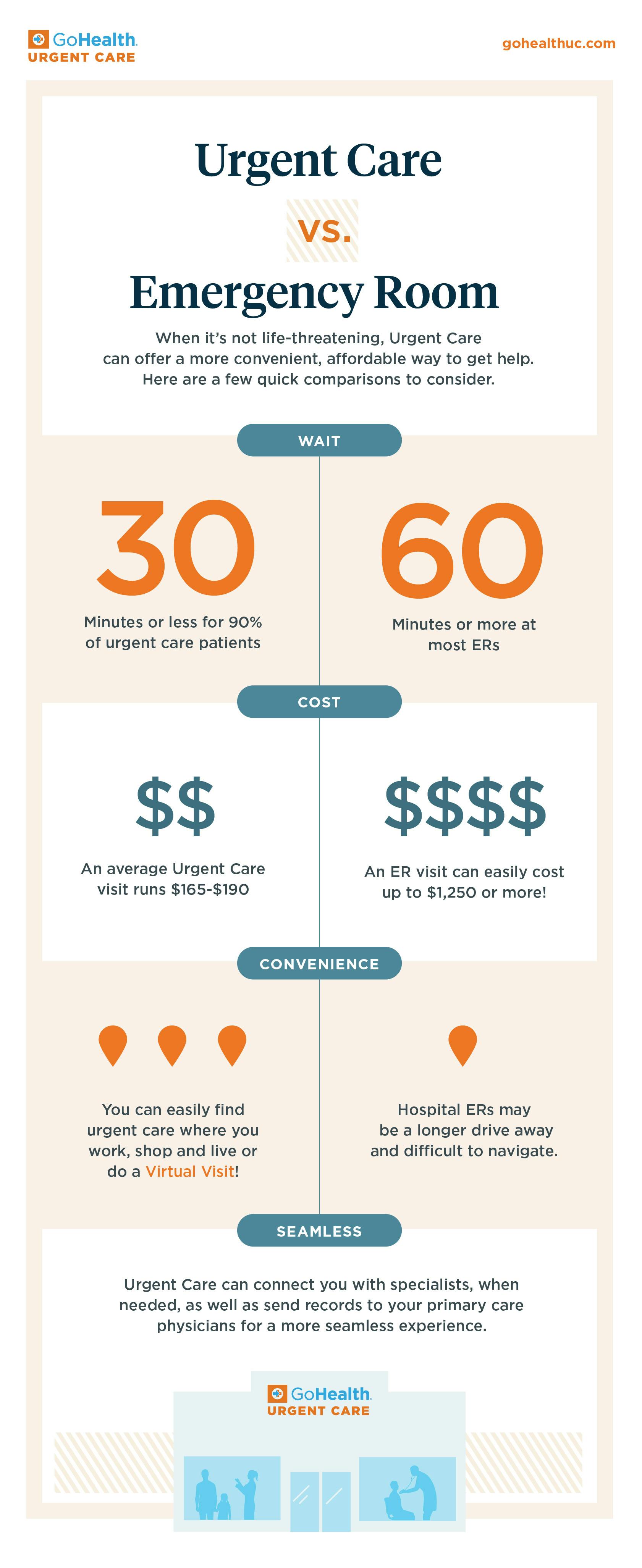Urgent care vs. emergency room
You’re cutting strawberries and you accidentally slice your thumb. The pain isn’t terrible, but the cut looks deep. It’s bleeding badly. So, what do you do? Do you visit your local emergency room (ER) or head to the nearest urgent care center?
This type of dilemma of deciding when to go to the ER or urgent care is one that many people face. Urgent care centers are popping up across the country, as they offer more affordable and faster care when compared to the emergency room. But most people don’t know what makes urgent care different from emergency care. When should you head straight to an ER?
But this is an important distinction, so let’s get to the bottom of these questions.

Difference between urgent care and emergency room
While you can visit either an emergency room or urgent care for your medical care, there are a few main differences to understand.
Hours of operation and staffing
The ER is open 24/7 for care, whereas urgent care centers are typically open through the evening and on weekends, while some centers are open until midnight.
Emergency departments are frequently busy and prioritize the most severe cases first. Depending on your needs, you may need to wait a long time for care. Most urgent cares allow you to walk in or save your spot online, which means a limited wait.
While the emergency room may have a wider variety of specialists on call, most urgent care centers are also staffed with knowledgeable providers. If you need a specialist, we have an extensive network of providers.
Health conditions treated
ERs are meant for potentially life-threatening emergencies. Urgent care centers can address many non life-threatening conditions, such as broken bones, but typically do not handle emergencies. But urgent care can also address nonurgent conditions that the ER does not, such as sore throats, STD testing, or other day-to-day medical concerns.
Seeing a provider at urgent care for any health condition is much more cost-effective when compared to the emergency room. An emergency visit can be costly depending on your deductible and insurance, whereas an urgent care visit is significantly less.
While you may sometimes need to visit an emergency room, urgent care centers are a much more cost-effective and efficient way to get the care you need.
When to go to urgent care
Urgent care centers are perfect for most non-emergency situations. They’re also ideal if something happens outside regular business hours. For example, most of our clinics are open until 8 p.m. on weekdays and from 9 a.m. to 4 or 5 p.m. on weekends, when most doctors’ offices are typically closed. Be sure to check the location hours.
Visit an urgent care center if you need help with any of the following:
- Minor fractures
- X-rays
- Back pain
- Nausea, vomiting and diarrhea
- Minor headaches
- Blood work
- Bumps, cuts and scrapes
- Fever
- Ear or sinus pain
- Vaccinations
- Cough or sore throat
- Lab services
- Animal bites
- Stitches
- Sprains and strains
- Mild asthma
- Foreign objects in the eyes or nose
- Allergies
- Rashes and minor burns
- Burning with urination
- Eye irritation, swelling, or pain
- Minor allergic reactions
- Cold or flu symptoms
- ER might be more appropriate for infants and toddlers
Why go to an urgent care? Here are a few reasons:
- 90% of urgent care patients wait 30 minutes or less to see a provider. Our website has a handy time clock that automatically tells you the expected wait upon arrival.
- 84% of urgent care patients are in and out within an hour.
- Walk-ins are welcome, and there’s no need to schedule an appointment, although you can save your spot online.
- Urgent care is more affordable. An ambulance ride to the ER can cost around $1,200 or more.
- Urgent care can be found in convenient, nearby locations like shopping centers and commercial plazas.
- Most urgent care centers take insurance. We are in-network with most major insurance providers, Medicare, Medicaid, workers’ compensation, and motor vehicle insurance. We even partner with businesses.
When to go to the ER
Emergency rooms are perfect for emergency situations. If you have a life-threatening condition, go straight to your nearest ER. Such conditions include:
- Chest pain
- Difficulty breathing
- Stroke
- Head trauma
- Severe bleeding
- Loss of vision
The difference between urgent care and emergency rooms is the severity of the health problem. If the condition is life-threatening, go to an emergency room.
When to call 911
Calling 911 should only be for emergencies when someone is unable to get to the ER or needs immediate medical attention. For example, if someone is unconscious or has a severe injury, particularly to the neck or spine, do not move them; call 911 instead.
Other times to call 911 may include:
- Accidental poisoning
- A deep cut or burn on the head, chest, or stomach
- Bleeding that cannot be controlled
- Head injury with confusion, vomiting, or loss of consciousness
- Heart attack or stroke
- Overdose due to drugs or medication
- Seizures
- Severe allergic reaction or asthma attack
- Trouble breathing, particularly if skin or lips are blue
Only call 911 if you or a loved one need medical attention immediately.
Visit an urgent care center near you
If the condition is a minor illness or injury, take advantage of the convenience and affordability by visiting one of our urgent care centers. We are open 365 days a year, seven days a week, to provide quality care for the whole family.
To start, find the center closest to you. Walk in, save your spot online, or schedule a virtual visit with one of our providers.
References:
- https://www.consumerreports.org/consumerist/164-per-mile-surprise-ambulance-bills-are-a-growing-problem-difficult-to-avoid/
Medically reviewed by J.D Zipkin, MD, MA, FAAP — By Sarah The barge, Physician Assistant on December 5th, 2023


